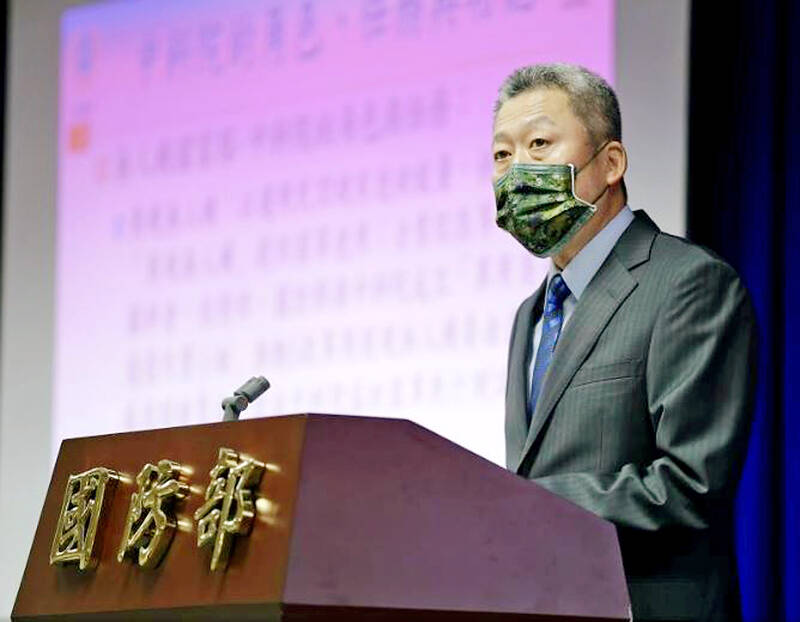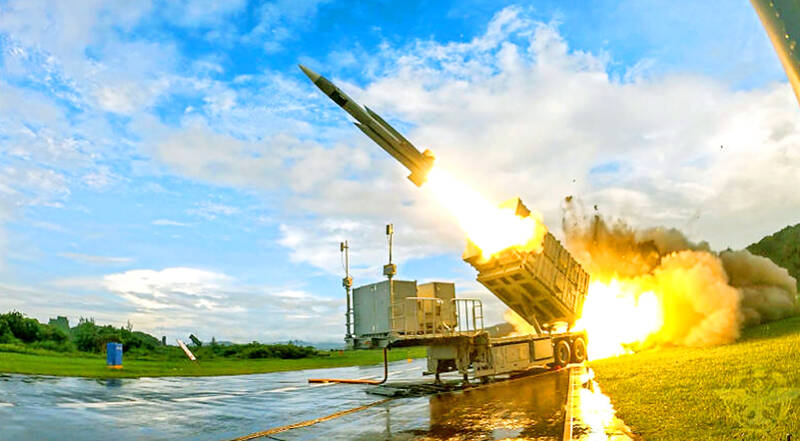The Chungshan Institute of Science and Technology yesterday said it is working with the private sector to develop uncrewed aerial vehicles (UAVs) for military use with the aim of building a drone fleet next year.
Chi Li-pin (齊立平), head of the institute’s Aeronautical Systems Research Division, said the goal is to build prototypes of five kinds of commercial drones customized for military purposes: carrier-launched drones, land-based surveillance drones, other surveillance drones, miniature drones and drones with target-acquisition capabilities.
The reason for using commercial platforms is to have them available for basic non-combat surveillance more quickly, Chi said.

Photo courtesy of the Military News Agency
Developing military-grade UAVs is a lengthy process that can take four to five years due to the military’s requirements, but commercial-grade drones can pass tests and be ready for military surveillance missions in about a year, he said.
The prototypes are expected to be delivered to the institute by July 31, as scheduled, he added.
The institute would be responsible for testing the drones and helping private manufacturers navigate the process, Chi said.

Photo courtesy of the Ministry of National Defense
Mass production could begin as soon as next year, once the drones pass the required tests, he said.
To ensure national security, the institute has required the partner companies to prove that they are not funded by firms based in China and that they do not have shares in China-based enterprises, Chi said.
They also pledged not to use products or components manufactured in China or by Chinese firms, he said.
Separately, a senior official familiar with the matter said on condition of anonymity that the institute is ramping up efforts to produce missiles with the goal of reaching maximum production volume no later than the end of next year.
This year’s production target of 1,000 missiles of all types represents a substantial increase over the 800 missiles produced last year, they said, adding that the institute’s 16 missile assembly lines are fully operational.
The missile assembly lines used to be semi-manual, which was a significant constraint on mass production, but the situation has improved following the opening of new factories, they added.
Additional reporting by Lo Tien-pin

The US government has signed defense cooperation agreements with Japan and the Philippines to boost the deterrence capabilities of countries in the first island chain, a report by the National Security Bureau (NSB) showed. The main countries on the first island chain include the two nations and Taiwan. The bureau is to present the report at a meeting of the legislature’s Foreign Affairs and National Defense Committee tomorrow. The US military has deployed Typhon missile systems to Japan’s Yamaguchi Prefecture and Zambales province in the Philippines during their joint military exercises. It has also installed NMESIS anti-ship systems in Japan’s Okinawa

‘WIN-WIN’: The Philippines, and central and eastern European countries are important potential drone cooperation partners, Minister of Foreign Affairs Lin Chia-lung said Minister of Foreign Affairs Lin Chia-lung (林佳龍) in an interview published yesterday confirmed that there are joint ventures between Taiwan and Poland in the drone industry. Lin made the remark in an exclusive interview with the Chinese-language Liberty Times (the Taipei Times’ sister paper). The government-backed Taiwan Excellence Drone International Business Opportunities Alliance and the Polish Chamber of Unmanned Systems on Wednesday last week signed a memorandum of understanding in Poland to develop a “non-China” supply chain for drones and work together on key technologies. Asked if Taiwan prioritized Poland among central and eastern European countries in drone collaboration, Lin

BACK TO WORK? Prosecutors said they are considering filing an appeal, while the Hsinchu City Government said it has applied for Ann Kao’s reinstatement as mayor The High Court yesterday found suspended Hsinchu mayor Ann Kao (高虹安) not guilty of embezzling assistant fees, reducing her sentence to six months in prison commutable to a fine from seven years and four months. The verdict acquitted Kao of the corruption charge, but found her guilty of causing a public official to commit document forgery. The High Prosecutors’ Office said it is reviewing the ruling and considering whether to file an appeal. The Taipei District Court in July last year sentenced Kao to seven years and four months in prison, along with a four-year deprivation of civil rights, for contravening the Anti-Corruption

NO CONFIDENCE MOTION? The premier said that being toppled by the legislature for defending the Constitution would be a democratic badge of honor for him Premier Cho Jung-tai (卓榮泰) yesterday announced that the Cabinet would not countersign the amendments to the local revenue-sharing law passed by the Legislative Yuan last month. Cho said the decision not to countersign the amendments to the Act Governing the Allocation of Government Revenues and Expenditures (財政收支劃分法) was made in accordance with the Constitution. “The decision aims to safeguard our Constitution,” he said. The Constitution stipulates the president shall, in accordance with law, promulgate laws and issue mandates with the countersignature of the head of the Executive Yuan, or with the countersignatures of both the head of the Executive Yuan and ministers or